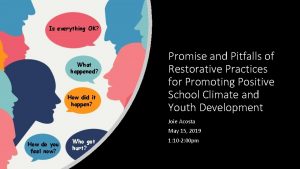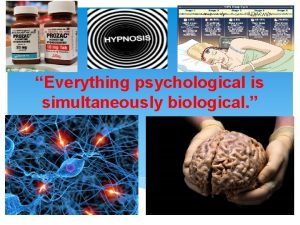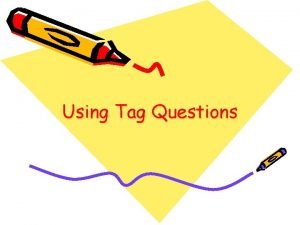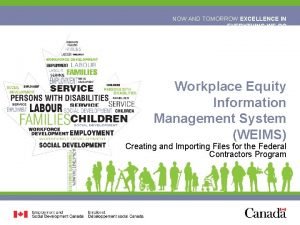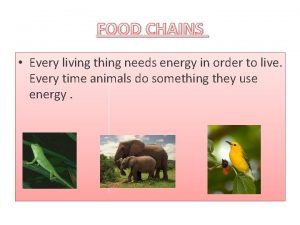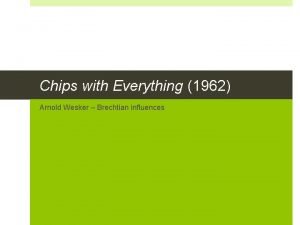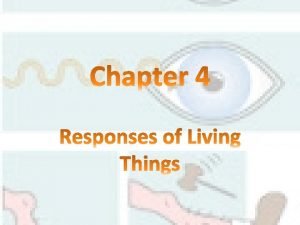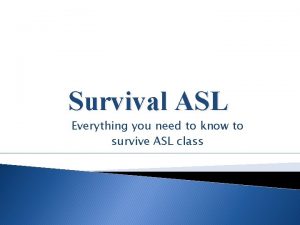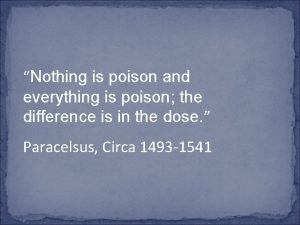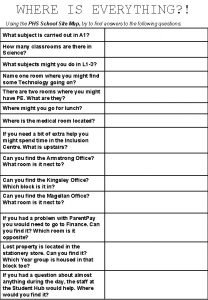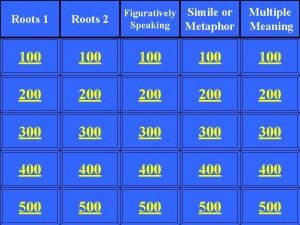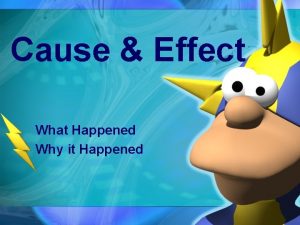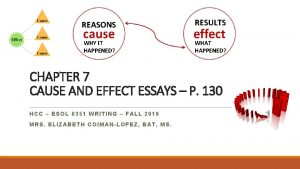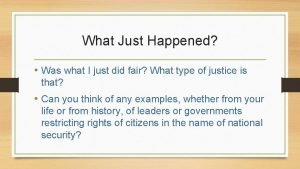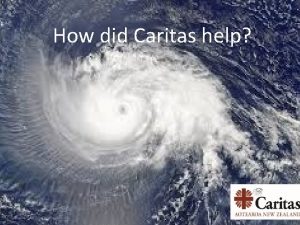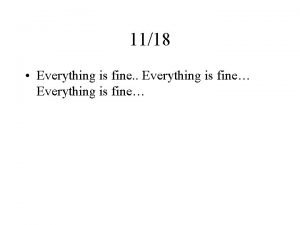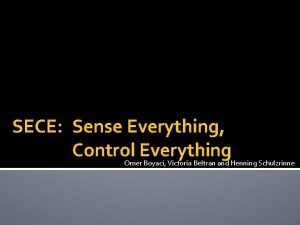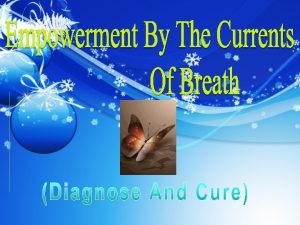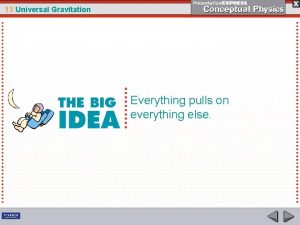Is everything OK What happened How did it







![Surveyed 416 staff and 2, 834 students Student characteristics Control N=1, 832 Age [M(SD)] Surveyed 416 staff and 2, 834 students Student characteristics Control N=1, 832 Age [M(SD)]](https://slidetodoc.com/presentation_image/5e709a9d5e3110e8ccb1f1df21d2a162/image-8.jpg)

































- Slides: 41

Is everything OK? What happened? How did it happen? Promise and Pitfalls of Restorative Practices for Promoting Positive School Climate and Youth Development Joie Acosta May 15, 2019 How do you feel now? Who got hurt? 1: 10 -2: 00 pm

Agenda for today’s presentation • Describe the unique features of IIRP’s Restorative Practices Intervention (RPI) • Report the design and findings from the first two randomized controlled trials of RPI • Share lessons learned and implications for practitioners and researchers

Flow for IIRP Restorative Practices Intervention Year 1 reflection and Year 2 planning meetings with Leadership Teams Monthly PLG meetings & consultation calls with Leadership Teams Summer Initial RP training for schools and formation of Professional Learning Groups (PLGs) │ │ Mid-year review with Leadership Teams at schools │ │ Summer Monthly PLG meetings & consultation calls with Leadership Teams continue │ Additional training for schools on balance of RP elements │ │ │ Mid-year review with Leadership Teams at schools │ │ │ Sustainability and data review with Leadership Teams Actual tasks/timeline vary by school

Features of IIRP Restorative Practices Intervention Maximizes positive affect through proactive practices (e. g. , restorative circles) to build closer bonds among youth Encourages free expression of emotion through training in Alternative to practices such as punitive approaches affective statements often used by Minimizes negative and questions to schools affect through promote responsive practices to (e. g. , zero-tolerance communication disciplinary policy) specific offenses to help youth take responsibility and reintegrate into community

Conceptualization of IIRP Restorative Practices Intervention 11 essential practices Improved school environment Positive youth development

Study 1: Maine Evaluation of a Whole-School Change Intervention Two-Year Cluster Randomized Trial of the Restorative Practices Intervention by Joie Acosta, Matthew Chinman, Patricia Ebener, Patrick S. Malone, Andrea Phillips, & Asa Wilks May 2019, Volume 48, Issue 5, pp. 876 -890

Randomized controlled study design 14 middle schools 7 treatment schools RPI for 2 years 7 control schools RPI after 3 years on wait list
![Surveyed 416 staff and 2 834 students Student characteristics Control N1 832 Age MSD Surveyed 416 staff and 2, 834 students Student characteristics Control N=1, 832 Age [M(SD)]](https://slidetodoc.com/presentation_image/5e709a9d5e3110e8ccb1f1df21d2a162/image-8.jpg)
Surveyed 416 staff and 2, 834 students Student characteristics Control N=1, 832 Age [M(SD)] 11. 52 (0. 70) Staff characteristics Treatment 11. 47 (0. 62) 48% 49% Grade 7 52% 51% Female 50% 48% Hispanic 3% 4% 18%* 20%* *significantly different at p<. 05 Treatment Classroom teacher 69% 70% Administrative 3% 5% MH professional 5% 7% Ed tech 17% 15% Student/teacher support staff 3% 2% Non-teaching staff (e. g. , nurse, librarian) 3% 2% N=1, 002 Grade 6 Non-white Control N=210 N=206

Examined outcomes before and for two years after RPI was implemented 1. Did RPI implementation influence 2 the school environment? Data Sources: ü Observations using the ü Surveys of staff and Youth Program Quality students Assessment ü Fidelity observation data 1. How well did schools 1 implement RPI ?

Examined outcomes before and for two years after RPI was implemented 3. Did RPI affect staff perceptions 4. Did RPI affect student 3 4 outcomes? of school climate? Data Source: Student survey Data Source: Staff survey ü ü ü Student input Positive peer interactions Teacher support Safety problems Classroom control üschool climate üschool connectedness üpeer relationships üsocial skills (assertion, empathy) übullying victimization (physical, verbal, cyber) üacademic achievement üsuspension rates

How well did schools implement RPI? 1 • Fidelity varied by practice, but was generally high Ratings on RPI Circle/Conference Fidelity 7 6 5 • Did not change from Y 1 to Y 2 4 3 2 1 en S C om m itm lvi m so le ob Pr Inter-rater reliability for observations ICC=. 71. t ng g kin -ta Year 2 sk Year 1 Ri Au t on o m y y nc Re le va pe ct S R A- sp R e es ec t es Ru l AA Ov e ra ll s uc ce ss 0 • But most circles failed to reach a successful resolution

1 How well did schools implement RPI? Teachers self-report showed significant improvement (Y 1 -Y 2)* in their: • Use of affective statement, discussion of restorative practice, informal use of restorative questions, and encouraging people beyond shame response (Past 60 day) • How well they were using two specific practices: restorative questions and small impromptu conferences But only about 1/3 of teachers reported using restorative practices more frequently over time • 29% for proactive circles • 32% for responsive circles *Estimated probability of change from Y 1 to Y 2 P< 0. 01

1 How well did schools implement RPI? Wide variability in student experiences of restorative practices within treatment schools (i. e. , some receiving RPI, some not) Student self-reported experience of restorative practices (Year 2) Number of students Treatment students Low RP High RP

1 How well did schools implement RPI? Student experiences of restorative practices did not significantly differ between treatment and control schools Student self-reported experience of restorative practices (Year 2) Treatment students Number of students Control students Low RP High RP

2 Did RPI implementation influence the school environment? No significant impact on whole school environment • No differences between treatment and control schools • No change in whole school environment over time School Level Environment (youth Program Quality Assessment Scores 6. 00 5. 00 4. 00 3. 00 2. 00 1. 00 0. 00 Emotional Safety Supportive Environment Control Pre Control Post Interaction Treatment Pre Treatment Post Engagement

3 Did RPI affect staff perceptions of school climate? Staff Perceptions of School Climate Student Input Positive Peer Teacher Support Safety Problems Classroom Control 0. 00 0. 50 1. 00 1. 50 Tx Post Tx Pre No significant differences 2. 00 Cont Post 2. 50 3. 00 Cont Pre 3. 50 4. 00 4. 50

3 Did RPI affect staff perceptions of school climate? Implementation Restorative Staff Community School Climate • Within treatment schools, SEM mediation* found that Restorative Staff Community mediated the influence of implementation on climate • Teachers who reported doing more restorative practices had significantly more positive perceptions of two domains of school climate: (1) clarity/consistency (p=. 006); (2) teacher support (p=. 046) *Using delta method standard errors (aka the Sobel test) and accounting for clustering

4 Did RPI affect student outcomes? Intent to treat analyses found no significant differences between students in control and treatment schools on: üperceptions of school climate üschool connectedness üpeer relationships üsocial skills (assertion, empathy) übullying victimization (physical, verbal, cyber) üacademic achievement üsuspension rates Wide variability in student experiences (i. e. , some receive RP, some not) I deleted the last line because it’s on the next slide: Better outcomes observed among students who experienced more RP

4 Did RPI affect student outcomes? Better outcomes for students who experienced more RP Amt per SD Clarity/ consistency** Teacher School support** climate Positive peer relations** SE 0. 33 0. 04 0. 42 0. 03 0. 23 0. 01 0. 38 0. 02 School connectedness** 0. 39 0. 03 Peer attachment** 0. 29 0. 05 Assertiveness** 0. 36 0. 06 Empathy** 0. 24 0. 03 Student input** Social skills Bullying OR CI (L, U) Amt per SD Physical 0. 87 (0. 74, 1. 01) -0. 15 Verbal 0. 86 (0. 62, 1. 20 -0. 15 Cyber** 0. 77 (0. 66, 0. 91) -0. 26 **significant at p<. 01

Study 2: Pittsburgh Can Restorative Practices Improve School Climate and Curb Suspensions? An Evaluation of the Impact of Restorative Practices in a Mid-Sized Urban School District by Catherine H. Augustine, John Engberg, Geoffrey E. Grimm, Emma Lee, Elaine Lin Wang, Karen Christianson, Andrea A. Joseph Available at www. rand. org/t/RR 2840

Randomized controlled study design 44 schools (K -12) 22 treatment schools RPI for 2 years 22 control schools RPI after 2 years on wait list

Pursuing Equitable and Restorative Communities (PERC) study schools spanned all grade levels Grade Configuration Number of Treatment Schools K– 5 11 K– 8 4 6– 12 2 9– 12 1 Total 22

RAND surveyed more than 600 staff at treatment schools and got district data on 11, 000 students across schools Staff characteristics Variable Unweighted Respondents Weighted Respondents All PERC Staff Standardized Difference Female 77% 75% 72% -0. 063 Male 23% 26% 0. 066 White 82% 76% 72% -0. 073 Black 15% 20% 23% 0. 080 Other race 3% 3% 3% 0. 001 Years in district 11. 2 11. 7 11. 8 0. 016 Classroom Teacher 74% 65% 61% -0. 088 Direct student staff 20% 22% 21% -0. 019 Indirect student staff 6% 12% 17% Attended IIRP training 88% 83% 80% 0. 123 -0. 079

Examined outcomes before and after PERC was implemented 11. How was PERC implemented? Data Sources: 2 2. Did PERC affect school climate? Data Sources: ü Surveys of staff (twice) ü Interviews of IIRP coaches and district leaders ü Four case study schools • • Observed 180 circles and conferences Interviewed 66 staff ü Surveys of staff (twice) ü Attendance records

Examined outcomes before and after PERC was implemented 33. Did PERC affect classroom climate? Data Source: Student survey 54. Did PERC affect schools’ approach to suspension? Data Source: Disciplinary records ü Overall classroom climate ü Teachers classroom management ü In-class peer support 4 Did PERC affect academic achievement? Data Source: Assessment scores üSuspension rates by offense üRepeat suspensions üRace/income üTransfers to alternative schools üArrests

1 How was PERC implemented? • Most aspects of RPI were well implemented • Buy-in was relatively high overall (around 3. 0 average both years) • Use was highest in elementary grades but increased significantly in middle and high schools from Year 1 to Year 2

2 Did PERC affect school climate? • Staff perceived a more positive climate in PERC schools than in control schools • PERC staff reported stronger relationships with students because of restorative practices • PERC reduced absences among elementary students

33. Did PERC affect classroom climate? • Students in PERC schools rated as worse: ü Overall classroom climate ü Teachers’ classroom management ü In-class peer support • But based on exploratory analyses, student survey results were no worse if the teachers reported being ‘high users’ of restorative practices

4 Did PERC effect academic achievement? • The combined math/language arts/science assessment score for grades 7 -8 worsened • Math scores for the state assessment in grades 3– 8 worsened • PERC had a negative impact on achievement for both black and white students at schools that are predominantly black

5 Did PERC affect schools’ approach to suspension? Overall, there was a 16% reduction in days of instruction lost to suspension PERC schools had: • Decreased days of suspension • Reduced rates of repeat suspensions • Reduced disparities by race and by income* • Reduced transfers to alternative placement schools Impacts were driven by elementary grades • No decreases for grades 6 -8 • No decreases in violent behavior/arrest for MS/HS students *But not by IEP status or by gender

Promises and Pitfalls?

Restorative practices, if used consistently, hold promise for improving both positive development and reducing problem behaviors

RPI can have positive impacts on school climate and suspension disparities, particularly at the elementary level

Implementation quality varied and teachers/staff wanted more support than RPI provided

RPI, as designed and supported, may not work for all schools

Schools need more intentional implementation Consultation model could be more intensive and include more specific guidance on implementation (targets, tools, etc. ) Leadership needs to encourage adoption and hold teachers accountable (e. g. , make training of leadership required)

More research is needed Unclear what all the barriers were to diffusion and need to understand more on how to maximize uptake Need more creative ways of capturing dose, given nature of interactional intervention

We must teach our children to resolve their conflicts with words, not weapons. President Bill Clinton

Acknowledgements Staffing • Maine: Pam Anderson, Margaret Micolichek, Chuck Saufler, Ansley Newton, Susan Savell • IIRP: John Baile, Mary Jo Hebling, Sharon Mast, Keith Hickman • Rutgers: Anne Gregory, Josh Korth • Pittsburgh Public Schools Funding • National Institute on Child Health & Human Development: Reducing Problem Behaviors Through PYD: An RCT of Restorative School Practices (1 R 01 HD 072235 -01 A 1). Acosta, PI • National Institute of Justice

For more information Joie Acosta, Ph. D. Senior Behavioral Scientist RAND Corporation Email: jacosta@rand. org Phone: 703 -413 -1100 x 5324

 What happened is everything ok
What happened is everything ok Chapter 22 farewell to manzanar
Chapter 22 farewell to manzanar What did you do on the weekend answer
What did you do on the weekend answer Fuiyou
Fuiyou How neurons communicate
How neurons communicate She is beautiful isn't she grammar
She is beautiful isn't she grammar Dog everything crane
Dog everything crane Kellogg's pep vitamins advertisement analysis
Kellogg's pep vitamins advertisement analysis Matter is anything that takes up space and has mass
Matter is anything that takes up space and has mass 20 minutes
20 minutes Fnet formula
Fnet formula Everything around us
Everything around us God sees everything
God sees everything Excellence in everything we do
Excellence in everything we do Everything's an argument chapter 17
Everything's an argument chapter 17 Anything that has mass and volume is
Anything that has mass and volume is God looked at everything he had made
God looked at everything he had made How many links are there in a food chain
How many links are there in a food chain Arnold wesker chips with everything
Arnold wesker chips with everything Everything that surrounds an organism
Everything that surrounds an organism Survive asl
Survive asl Shall i compare thee to a summer's day theme
Shall i compare thee to a summer's day theme What is it
What is it 31536000/3
31536000/3 Tag question everything
Tag question everything Rijandael
Rijandael How everything
How everything Is engineering everything
Is engineering everything Good knowing
Good knowing Everything is nothing
Everything is nothing Everything begins with cells
Everything begins with cells Everything that lives and moves about will be food for you
Everything that lives and moves about will be food for you Everything finder
Everything finder Everything is poison
Everything is poison Lord i lift everything to you
Lord i lift everything to you Pershore template
Pershore template Behold i make everything new
Behold i make everything new Marketing is everything
Marketing is everything Galileo free fall
Galileo free fall Everything around you is made up of
Everything around you is made up of Hannah isherwood
Hannah isherwood The avalanche devoured anything standing in its way
The avalanche devoured anything standing in its way
